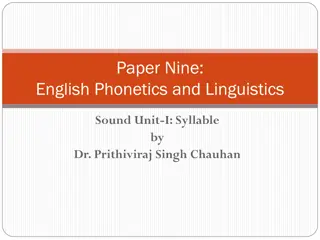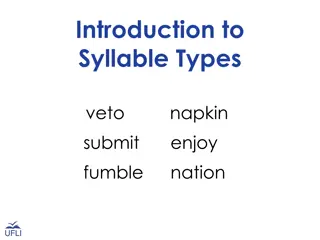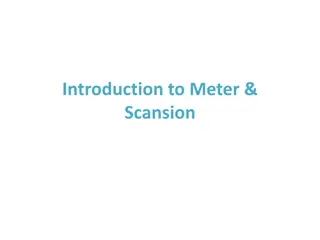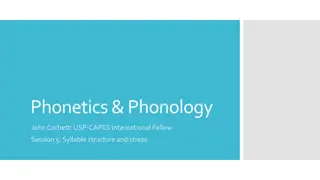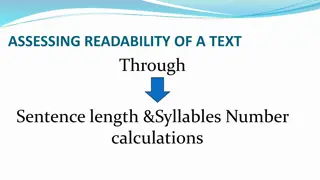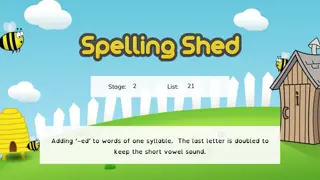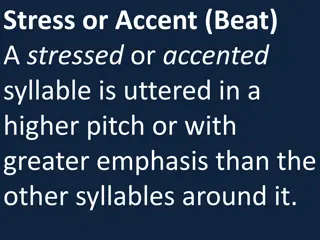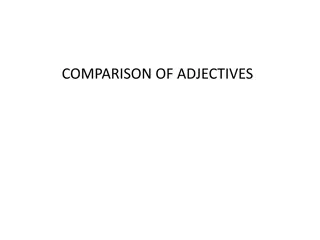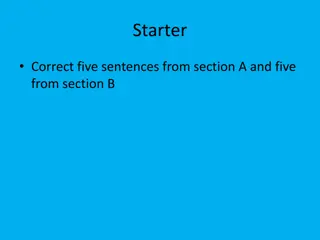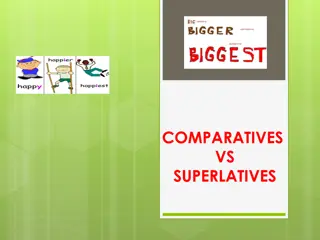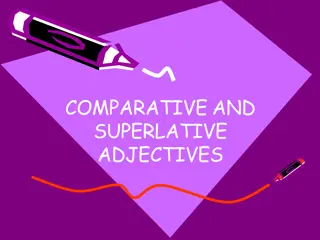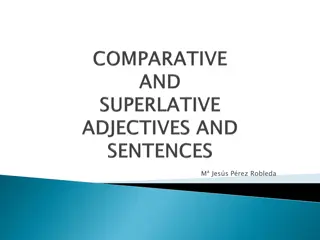Understanding Syllable Types in English Language
Syllables in English are categorized into open and closed syllables based on their endings. Open syllables have an onset and nucleus without a coda, while closed syllables include a coda. Additionally, syllables can be simple (with a vowel or single consonant) or complex (with consonant clusters). The distinction between strong and weak syllables is based on vowel types or syllabic consonants. Various examples and structures illustrate these distinctions.
- English language
- Syllable types
- Open and closed syllables
- Simple vs complex syllables
- Strong vs weak syllables
Download Presentation

Please find below an Image/Link to download the presentation.
The content on the website is provided AS IS for your information and personal use only. It may not be sold, licensed, or shared on other websites without obtaining consent from the author. Download presentation by click this link. If you encounter any issues during the download, it is possible that the publisher has removed the file from their server.
E N D
Presentation Transcript
1.3 Types of the Syllable in English 1.3.1 Open Vs. Closed Syllables Syllables are divided into open and closed according to the ending of the syllable. Yule (2006: 47) distinguishes two types of syllables, namely open syllables, which have an onset and nucleus, but no coda, as in me, to, no, etc.; and closed syllables, which occur in the cases when a coda is present, such as hit, kill, send, etc.
Cox et al., (2004: Internet Ref. No. 1) show the different structures of the syllable each type in English monosyllabic words, as illustrated below: Table (1.1) Open and Closed Syllables Open syllables V CV CCV CCCV Closed syllable VC VCC VCCC Example I tea spy spray Example eat ant ants Transcription /aI/ /ti:/ /spaI/ /spreI/ Transcription /i:t/ / nt/ / nts/ /prI mpts/ (the second syllable) /m n/ /bond/ /b nds/ /sIks s/ /br g/ /br gz/ /pl nts/ /sprI / /sprI z/ /splInts/ VCCCC pre-empts CVC CVCC CVCCC CVCCCC CCVC CCVCC CCVCCC CCCVC CCCVCC CCCVCCC man bond bands sixths brag brags plants spring springs splints CCCVCCCC strengths /stre k s/
1.3.2 Simple Vs complex syllables To start with, a simple syllable can be defined as "a syllable with a vowel or a vowel accompanied by a single consonant or a vowel followed and preceded by a single consonant". All other kinds of syllables can be thought of as complex syllables, such as a syllable with consonant clusters in the onset and/or the coda (Cox et. al., 2004: 1).
Singh and Singh (1979: 109) propose fifteen kinds of syllables, the first four are simple and the rest are complex. See table (3.2) on page (34) Table (1.2) Simple and Complex Syllables Syllable type V CV VC CVC CCV VCC CCVC CCCVC CCCVCC CCCVCCCC CVCC CVCCCC CCVCC CCVCCC CVCCC Example a/ / the / / or / / it / t/ sit /s t/ tree /tri / east /i st/ stood /st d/ street /stri t/ streets /stri ts/ strengths /stre k s/ sips /s ps/ tempts/tempts/ treats /tri ts/ sphinx /sf ks/ depths /dep s/
1.3.3 Strong Vs. Weak Syllables Roach (2010: 63) states that weak syllables can only have four types of centre as shown below: 1. The vowel / /. 2. The close front unrounded vowels in the general area of /i / and / /. 3. The close back rounded vowels in the general area of /u: / and / /. 4. A syllabic consonant.
On the other hand, a heavy syllable is one whose rhyme can take any of the following shapes: 1. A long vowel with or without a coda. 2. A short vowel with a coda made up of two or more consonants. 3. A short vowel followed by at least one consonant (ibid.).






